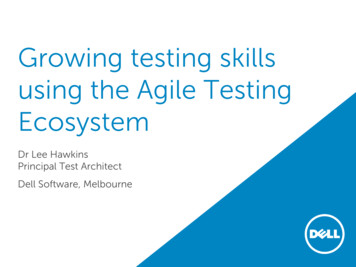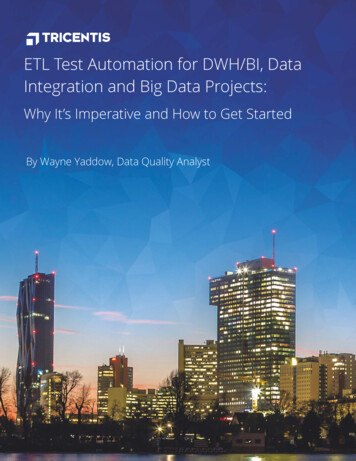
Transcription
Growing testing skillsusing the Agile TestingEcosystemDr Lee HawkinsPrincipal Test ArchitectDell Software, Melbourne
Who am I? 16 years at Quest Software / DellSoftware in Melbourne, Australia. Really testing since 2007 afterattending Rapid Software Testingwith Michael Bolton. Current role is Principal TestArchitect (aka “helping teams to dobetter testing”)We deliver scalable and affordablesolutions that simplify IT and mitigaterisk. Our offerings, when combinedwith Dell hardware and services, driveunmatched efficiency to acceleratebusiness results.2Dell - Internal Use - Confidential
Overview The problems we were trying tosolve “Testing Quadrants” models andthe Agile Testing Ecosystem(Bach/Bolton) How we have used this model Lessons learned Summary3Dell - Internal Use - Confidential
The problemswe were tryingto solve4Dell - Internal Use - Confidential
Problems (1) The number of projects adopting agile practices has increasedrapidly throughout Dell Software. Lots of (“manual”) testers struggling to find their way in these newproject environments. “Traditional” testing mentality and approach prevalent. Focus on defect detection (not prevention). Managers still relying on inappropriate testing metrics. Inability to complete feature testing within sprints. Automation always playing catch-up.5Dell - Internal Use - Confidential
Problems (2) Some context:– Large number of junior testers hired in low-cost locations (in anoffshored, rather than outsourced, model)– Small number of testing teams operating in a more context-drivenfashion My attempts at advocating for earlier involvement of testers wasgenerally not very effective. So I was looking for a way of helping to transition testers awayfrom simply being test executors to becoming quality assistantsthroughout sprints:– How to explain the need for this change to management?– What model or framework could I use to help?– How could I take such a model and reinforce it with practical steps?6Dell - Internal Use - Confidential
“TestingQuadrants”models and theAgile TestingEcosystem7Dell - Internal Use - Confidential Brian Marick (2003) Gregory & Crispin (2009 & 2014) Elisabeth Hendrickson (2012) Gojko Adzic (2013) James Bach & Michael Bolton(2014)
“Testing Quadrants” models – Brian Marick (1) Marick version appeared in August 2003 in a blog post todescribe types of tests used in XP projects:8Dell - Internal Use - Confidential
“Testing Quadrants” models – Brian Marick (2)1.Technology-facing programmer support– Test-driven development, “checked examples”2. Business-facing team support– “Provoking the programmers to write the right code”3. Business-facing product critiques– Exploratory testing4. Technology-facing product critiques– Non-functional tests (“ilities”)9Dell - Internal Use - Confidential(Note: numbering is mine)
“Testing Quadrants” models – Brian Marick (3) After this series of blog posts, Marick noted (October 2003):“Thus ends my essay on where agile testing is going and shouldgo. I want to reemphasize that I fully expect I'll look back on it infive years and think "How naïve". That's always been the case inthe past. Why should the future be different?I like being wrong, as long as the wrongness is a step along aproductive path. I feel that way about this essay.”10Dell - Internal Use - Confidential
“Testing Quadrants” models – Gregory & Crispin (4) Janet Gregory & Lisa Crispin version first appeared in their book“Agile Testing” in 2009 (about five years after Marick’s original ):11Dell - Internal Use - Confidential
“Testing Quadrants” models – Gregory & Crispin (5) This version decorated Marick’s version with some explicit typesof testing marked on the quadrants, which they labelled Q1-4. “Support Programming” became “Supporting the Team”. They also added the “clouds” on the corners to indicate how thetesting might be performed for each quadrant. Q1 and Q2 focused on defect prevention, Q3 and Q4 on defectdetection.12Dell - Internal Use - Confidential
“Testing Quadrants” models – Gregory & Crispin (6) Modified again in “More Agile Testing” in 2014:- “Supporting Programming/The Team” became “Guide Development”.- More examples in each quadrant.13Dell - Internal Use - Confidential
“Testing Quadrants” models – Hendrickson (7) From Elisabeth Hendrickson’s keynote presentation at CAST2012 “The Thinking Tester, Evolved”. Highlights checking expectations against exploring risks.14Dell - Internal Use - Confidential
“Testing Quadrants” models – Gojko Adzic (8) Blog post from Gojko Adzic “Let’s Break The Agile TestingQuadrants” (2013). Keeps the “Business” vs “Technology” facings, but changes theother facings (in line with “testing” vs “checking”).15Dell - Internal Use - Confidential
The Agile Testing Ecosystem – Bach/Bolton (1) In June 2014, James Bach presented at the Sydney TestersMeetup, on “The REAL Agile Testing Quadrants” and I liked what Isaw in that presentation. James then gave a talk on these quadrants at Oredev 2014. But why the need for (yet) another version? His criticisms ofprevious quadrants included:- Perpetuate the ignorant attitude that testers don’t belong in Agileunless they write code.- Confusing “output checking” with “testing”.- Implication that critiquing the product is not supporting the work ofprogramming.- “Facings” are beside the point - it’s all about business and for business- Making confusing and unnecessary distinctions about testing “donemanually” and testing “done by tools”.16Dell - Internal Use - Confidential
The Agile Testing Ecosystem – Bach/Bolton (2) James on the purpose of this model:“To provide a conversational tool to help talk abouttesting activities, shallow and deep. How developersand testers can work together to perform both.”17Dell - Internal Use - Confidential
The Agile Testing Ecosystem (3)18Dell - Internal Use - Confidential
The Agile Testing Ecosystem – version 1.0 (4)19Dell - Internal Use - Confidential
The Agile Testing Ecosystem – some key ideas (5) Close ties with agile principles:- “Discover something worth building” high value of product- “Build with change in mind” low cost of development Highlights the idea of “critical distance”:- Bottom right – developer/builder mindset- Top left – tester mindset- Deep testing tends to require or create more distance from thebuilder’s mindset. I like the way they have included some examples of things todo/think about (for both developers and testers) in each quadrant- this makes the model immediately useful and a way to startconversations about testing throughout the cycle.20Dell - Internal Use - Confidential
How we’ve usedthis model21Dell - Internal Use - Confidential
How we’ve used this model (1) After seeing the Bach/Bolton model, I started mind mapping eachquadrant – this has taken up my office whiteboard ever since:22Dell - Internal Use - Confidential
How we’ve used this model – for managers (2) This version of the quadrants uses readily understandable termsand ideas, no “testing speak” here to confuse. Good way to communicate how testing can play a partthroughout the whole sprint, not just using testing as a safetymechanism at the end. Years of advocacy on risk-based testing, exploratory testing, andembedding testers through agile development teams – but thismodel has already yielded the most obvious “a-ha” moments.23Dell - Internal Use - Confidential
How we’ve used this model – for testers (3) For each quadrant, I produced wiki articles, forming a series thatapplies testing across the entire sprint cycle. Mind map and theory- Background for those unfamiliar with the ideas or activities. Some example activities- Fleshing out the theory with some example activities. Tips for getting started- “Calls to action”, especially for new players. Resources- Links to articles, blogs, books, etc. Let’s look at an example, for the “Testing that helps develop thevision of the product” quadrant.24Dell - Internal Use - Confidential
How we’ve used this model – for testers (4) Quadrant item: Explore definitions of “done” Question acceptance criteria- Completeness and use of examples (concrete over abstract)- Advocate for testability- Think about exploratory testing charters (rough estimates ready forsprint planning – “tester velocity”) What should be automated?- Think about unit tests- Think about API tests- Minimize functional UI (workflow) tests Tips for getting started- Be part of user story review meetings – invite yourself if need be- Testability is crucial for you as the tester for deeper testing, so it’s inyour interest to ask for what you need as early as possible.25Dell - Internal Use - Confidential
How we’ve used this model – for testers (5) Quadrant item: Refine user stories Review- Think of reviewing stories as another testing activity – so apply yourtest heuristics & critical thinking skills- Ask clarifying questions- Look for testability- Look for hidden assumptions- Perform risk analysis Tips for getting started:- Make yourself part of user story review meetings- Use test heuristics to find gaps and inconsistencies in stories, sostakeholders soon start to value your input (then actively seek it)- Hold a risk analysis session to bring different stakeholders together(diverse opinions).26Dell - Internal Use - Confidential
Lessons learned27Dell - Internal Use - Confidential
Lessons learned This is a great model for communicating the message thattesting happens throughout the iteration.-But, not all teams (and managers) are ready for testers to beinvolved throughout iterations yet.Many of the inexperienced junior testers still need absorb the factthat their work isn’t just writing out defects, it is helping to deliversoftware. This is a great model to counter the “all testing is automated inagile” mindset. Works better with mature developers and testers. Explicit “calls to action” from the model work well to increaseadoption & encourage teams to interpret in their own context. The changes to make this successful are not just about testing– there are changes for everyone in the team (even managers). Challenges for factory thinkers and metrics maniacs.28Dell - Internal Use - Confidential
Closing remarks29Dell - Internal Use - Confidential
Closing remarks Models can be useful but also dangerous. Use them as conversation pieces to get people talking abouttesting in the way you want to encourage them to think. There are many “testing quadrants” models available – try someand see what works (and what doesn’t) in your context. The Bach & Bolton “Agile Testing Ecosystem” is proving to be auseful tool in helping testing move across the whole iteration inagile teams. This model emphasizes whole team responsibility for testing. But (as with any model) it’s not a silver bullet. We have a very longway to go with many teams.30Dell - Internal Use - Confidential
Contact therockertester.wordpress.com31Dell - Internal Use - Confidential
References (1)My Agile Testing Project (Brian Marick #agile-testing-project-1“Agile Testing/More Agile Testing” books (Gregory & Crispin)http://agiletester.ca/(Free chapter 8 on planning using t/uploads/sites/26/2014/09/Gregory Chapter 8 Final.pdf )The Thinking Tester, Evolved (Hendrickson, CAST hinking-tester-evolvedLet’s Break The Agile Testing Quadrants (Gojko Adzic gile-testing-quadrants32Dell - Internal Use - Confidential
References (2)The Trouble with Models – Specifically the Agile Testing Quadrants(Janet Gregory g-quadrantsAgile Test Planning with the Agile Testing Quadrants (Lisa estPlanning.pdfThe REAL Agile Testing Quadrants (James Bach, Sydney RSTQuadrants.pdfSkilled Testing and Agile Development Integrated (James Bach,Oredev 2014):https://vimeo.com/11162183133Dell - Internal Use - Confidential
The Agile Testing Ecosystem – Bach/Bolton (1) In June 2014, James Bach presented at the Sydney Testers Meetup, on “The REAL











